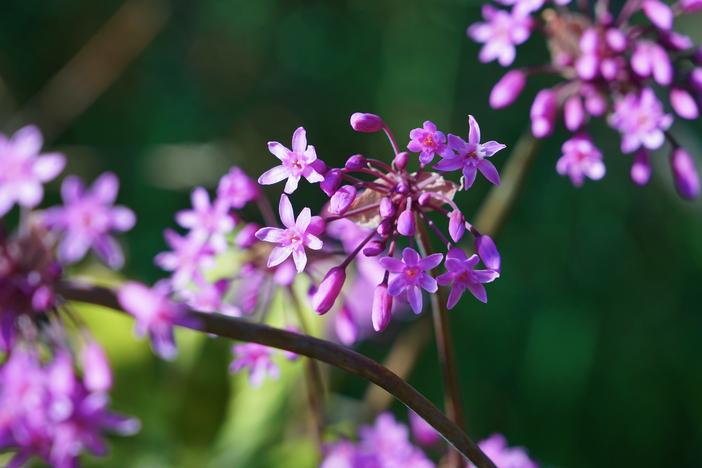Pink Agapanthus
(Tulbaghia simmleri)
Pink Agapanthus (Tulbaghia simmleri)
/
/

Eria Wei
CC BY-SA 4.0
Image By:
Eria Wei
Recorded By:
Copyright:
CC BY-SA 4.0
Copyright Notice:
Photo by: Eria Wei | License Type: CC BY-SA 4.0 | License URL: https://creativecommons.org/licenses/by-sa/4.0 | Uploader: Eri0n0ire | Publisher: Wikipedia Commons

















Estimated Native Range
Summary
Tulbaghia simmleri, commonly known as Pink Agapanthus or Fragrant Tulbaghia, is a perennial herb native to the grasslands and rocky outcrops of the Northern Provinces of South Africa. It typically grows to a height of 18-24 inches (45-60 cm) with a similar spread. The plant features narrow, strap-like leaves and bears clusters of fragrant, trumpet-shaped, pale pink to mauve flowers with darker pink or purple corona-like structures, blooming from mid-summer to early autumn. The flowers are particularly showy and can add a splash of color to the garden when many other plants have finished flowering.
Tulbaghia simmleri is valued for its ornamental flowers and pleasant fragrance, making it a popular choice for borders, rock gardens, and as a container plant. It is also used in culinary applications, as the leaves and flowers are edible and have a garlic-like flavor. This plant is relatively easy to maintain, requiring minimal care once established. It prefers well-drained soil and can tolerate a range of soil types, from sandy to loamy. While it thrives in part shade to full sun, it benefits from some afternoon shade in hotter climates. Overwatering should be avoided to prevent root rot. Tulbaghia simmleri is generally pest and disease-free but can be affected by snails and slugs. It is not considered invasive when grown outside its native range.CC BY-SA 4.0
Tulbaghia simmleri is valued for its ornamental flowers and pleasant fragrance, making it a popular choice for borders, rock gardens, and as a container plant. It is also used in culinary applications, as the leaves and flowers are edible and have a garlic-like flavor. This plant is relatively easy to maintain, requiring minimal care once established. It prefers well-drained soil and can tolerate a range of soil types, from sandy to loamy. While it thrives in part shade to full sun, it benefits from some afternoon shade in hotter climates. Overwatering should be avoided to prevent root rot. Tulbaghia simmleri is generally pest and disease-free but can be affected by snails and slugs. It is not considered invasive when grown outside its native range.CC BY-SA 4.0
Plant Description
- Plant Type: Bulb
- Height: 1-2 feet
- Width: 0.8-1 feet
- Growth Rate: Rapid
- Flower Color: Pink, White
- Flowering Season: Winter, Spring
- Leaf Retention: Evergreen
Growth Requirements
- Sun: Part Shade, Full Sun
- Water: Medium
- Drainage: Medium
Common Uses
Bee Garden, Butterfly Garden, Drought Tolerant, Low Maintenance, Potted Plant, Showy Flowers, Street Planting
Natural Habitat
Native to the grasslands and rocky outcrops of the Northern Provinces of South Africa
Other Names
Common Names: Fragrant Tulbaghia, Pink Agapanthus
Scientific Names: , Tulbaghia simmleri, Tulbaghia fragrans, Tulbaghia daviesii, Tulbaghia pulchella,
GBIF Accepted Name: Tulbaghia simmleri Beauverd